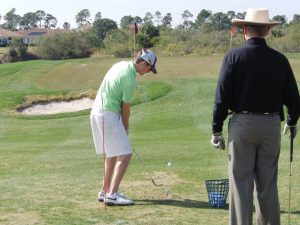Short Game – Technique and Touch

By Dr. T. J. Tomasi, Keiser University College of Golf Senior Faculty and Director of Research
The great Bobby Jones once said a player who can string together ‘three of them and one of those’ is a match for anyone. So, while the long game is glamorous, the short game is the great equalizer. Thus at least 60% of your practice time should be devoted to chipping/pitching, putting, and bunker play using the following learning model.
Review Your Short Game
First: Review your short game – write in your journal all you know about each part – for example, the How-I-Chip technique – then graduate to using that technique by adjusting your touch from several real-life situations. Then return to your journal and write down any problems or additions uncovered by your self-assessment. Anything you can’t fix or figure out should send you on a trip to see the wizard. That is, get some help.
In your next practice session, take the Technique/Touch paradigm below for a spin to learn its ins and outs – you will then use it as the study model anytime you want to learn something.
Stage One: Technique
With your journal as a guide (bring it to the range), run through your checklist of fundamentals such as ball position, weight distribution, when and how to set the wrists, etc. Next, hit a few shots with no particular target in mind – the focus is “did I do it correctly” rather than “where did it end up.” You may hit 35 balls from the same spot while not caring about results because only the form of your swing is important at this stage. (In most golf learning, video is very helpful.)

Once you are confident with your technique, it’s time for stage two, where you develop your touch. By the way, if you’re a faithful reader of my golf books (16 in all), you’ll know all about short-game techniques. If not, assess yourself with a two-shot penalty, then see my book “Play Better Golf.”
Stage Two: Touch
To have a good short game, you must be able to move your focus from Technique to Target on time, every time. At this stage, your concern is not “how you do something” but how close you are to your target. Take a handful of balls and toss them over your shoulder, then play them as they lie, one at a time, until you hole each one out. Play the ball as you find it, hit it to your target, putt the ball in the hole, then go back and play the next ball. This is how you do it on the course, so it should be how you practice. Keep track of your ability to get it up and down from different lies, and keep track of lies that give you trouble, then focus on those lies until they become strengths.

Here is the rule you should live by: When you’re hitting toward a target, there are no mechanics; when you’re practicing mechanics, there’s no target.
In conclusion, while the long game may seem more glamorous, the short game is the true equalizer in golf. Mastering the short game can make you a match for anyone. Therefore, it is crucial to devote a significant portion of your practice time to chipping, pitching, putting, and bunker play. Utilize the learning model discussed above, focusing first on technique and then on touch. Remember to shift your focus from mechanics to the target when hitting toward a target, and vice versa when practicing mechanics. Don’t hesitate to seek help if there are aspects of your game that you can’t figure out or fix on your own. And finally, practice as you play on the course, and continuously work on transforming your weaknesses into strengths. By following these principles and putting in the necessary practice, you can significantly improve your short game and, consequently, your overall performance on the golf course.
Learn more!
Want more tips? If you want to take your game to the next level, contact our team at Keiser University’s College of Golf & Sport Management today. With our dedication and experience, together, we can elevate your game to new heights. Give us a call today at 888-355-4465.














